Edward Mitchell Bannister
Edward Mitchell Bannister (November 2, 1828 – January 9, 1901) was a Black Canadian-American Tonalist painter. Like other Tonalists, his style and predominantly pastoral subject matter were drawn from his admiration for Millet and the French Barbizon School.

Edward Mitchell Bannister | |
|---|---|
 Rhode Island Black Heritage Society (carte de visite) | |
| Born | November 2, 1828 Saint Andrews, New Brunswick, Canada |
| Died | January 9, 1901 |
| Resting place | North Burial Ground, Providence |
| Nationality | Canadian, American |
| Known for | Painting |
| Movement | Tonalism |
Biography

Bannister was born in St. Andrews, New Brunswick and moved to New England in the late 1840s, where he remained for the rest of his life. Bannister was well known in the artistic community of his adopted home of Providence, Rhode Island and admired within the wider East Coast art world: he won a bronze medal for his large oil "Under the Oaks" at the 1876 Philadelphia Centennial. But he was largely forgotten for almost a century for various reasons, principally racial prejudice. Bannister began his official career as an artist when an article in the 1867 New York Herald belittled both him and his work, stating "[...] the negro has an appreciation for art while being manifestly unable to produce it." Prior to working as a painter, Bannister worked as barber and tinted photos. In the late 1850s he attended lectures given by D. William Rimmer, a sculptor noted for his accuracy in rendering the human figure. Over the course of his career, Bannister was inspired by the Barbizon school-influenced paintings of William Morris Hunt who had studied in Europe and held numerous public exhibitions in Boston around the 1860s. Although committed to freedom and equal rights for Afro-Americans, he chose not to inject those issues into his work, adopting instead a spiritual philosophy and individually expressive style which represented harmony and liberty on a more universal plane.
As his career matured, Bannister accumulated many honors, several from the Massachusetts Charitable Mechanics Association. His two biggest support systems were his mother, who was the catalyst from the very beginning for his passion for the arts, and his wife, who also was an activist. Both strong supporters of abolition, wife Christina lobbied for equal pay for black soldiers during the Civil War and also organized the soldiers’ relief fair in 1864. In 1880, Bannister joined with other professional artists, amateurs, and art collectors to found the Providence Art Club to stimulate the appreciation of art in the community. Bannister was the only major African American artist of the late nineteenth century who developed his talents without the benefit of European exposure.
Although primarily known for his idealised landscapes and seascapes, Bannister also executed portraits, biblical and mythological scenes, and genre scenes. An intellectual autodidact, his tastes in literature were typical of an educated Victorian painter, including Spenser, Virgil, Ruskin and Tennyson, from whose works much of his iconography can be traced. His work reflected the composition, mood, and influences of French Barbizon painters Jean-Baptiste-Camille Corot, Jean-François Millet, and Charles-François Daubigny. He had an affinity for Native American thought.
Bannister died of a heart attack in 1901 while attending a prayer meeting at his church, Elmwood Avenue Free Baptist Church. He is buried in the North Burial Ground in Providence.
Legacy
With the ascendency of the civil rights movement in the 1970s, Bannister's work was again celebrated and collected. In 1978, Rhode Island College dedicated its Art Gallery in Bannister's name with the exhibition: "Four From Providence ~ Alston, Bannister, Jennings & Prophet". This event was attended and commented on by numerous notable political figures of the time, and supported by the Rhode Island Committee for Humanities and the Rhode Island Historical Society.
E. M. Bannister Gallery at Rhode Island College is named after Bannister.[1]
The historian Anne Louise Avery is currently compiling the first Catalogue Raisonné and major biography of Bannister's work. See the International Foundation for Art Research for further details.
House
The house at 93 Benevolent Street in Providence, where Bannister lived between 1884 and 1899, was owned by Brown University until 2016. Brown renovated the property and restored it to its original appearance,[2] and it was sold to Professor Jeff Huang as part of the Brown to Brown Home Ownership Program.
Important works
- The Newsboy [Boston Newsboy] [Newspaper Boy] (1869; Oil; Smithsonian American Art Museum, Washington, D.C.)[3]
- River Scene (1883; Oil on canvas; Honolulu Museum of Art)
- Sabin Point, Narragansett Bay (1885; Oil on canvas; Gardner House, Providence, Rhode Island)
- Palmer River (1885; Oil on canvas; Private Collection)
- The Farm Landing (1892; Oil on canvas; King Gallery of Fine Art)
- Moon Over Harbor (1868; Oil on fiberboard; Smithsonian American Art Museum)
- Last Light (1890s; Oil on wood panel; Baltimore Museum of Art)
Gallery
_-_Walters_372766.jpg) Boston Street Scene (Boston Common), (1898–99). The Walters Art Museum.
Boston Street Scene (Boston Common), (1898–99). The Walters Art Museum. Newspaper Boy, 1869, Smithsonian American Art Museum
Newspaper Boy, 1869, Smithsonian American Art Museum Driving Home the Cows, 1881, Smithsonian American Art Museum
Driving Home the Cows, 1881, Smithsonian American Art Museum- River Scene by Edward Mitchell Bannister, 1883, oil on canvas, Honolulu Museum of Art
 Palmer River, 1885[4]
Palmer River, 1885[4]
Notes
- "Edward Mitchell Bannister". Rhode Island College. Retrieved 2014-03-16.
- Coelho, Courtney (13 May 2015). "Brown to renovate historic Bannister House". News from Brown. Brown University. Retrieved 15 May 2015.
The house at 93 Benevolent Street, once home to African American artist Edward Mitchell Bannister and currently owned by Brown University, will be fully renovated, returned to its original wood exterior ...
- "Newspaper Boy by Edward Mitchell Bannister / American Art". si.edu. Retrieved 2 May 2015.
- "Palmer River". The Athenaeum. Retrieved 5 August 2015.
Bibliography
- Bannister, Edward Mitchell. Edward M. Bannister: A Centennial Retrospective. Newport, R.I.: Roger King Gallery of Fine Art, 2001. OCLC 49568395 Edward M. Bannister: a centennial retrospective. (WorldCat.org)
- Bearden, Romare and Harry Henderson, A History of African American Artists from 1792 to the Present (Pantheon, 1993).
- Holland, Juanita Marie and Corinne Jennings, Edward Mitchell Bannister, 1828-1901, New York, Harry N. Abrams, 1992, ISBN 0810968118
- Perry, Regenia A., Free within ourselves: African American artists in the collection of the National Museum of American Art. Smithsonian Inst., 1992. pp. 23–27.
- Hartigan, Lynda Roscoe, Sharing Traditions: 5 Black Artists in 19th-Century America. Washington DC: Smithsonian Institution Pr., 1985, pp. 69–82.
- Bannister, Edward Mitchell, and Juanita Marie Holland, Edward Mitchell Bannister, 1828-1901. Kenkeleba House, 1992.
- "Edward Mitchell Bannister". YourDictionary, n.d. Web. 26 October 2017. http://biography.yourdictionary.com/edward-mitchell-bannister.
- Van Siclen, Bill, "The Varied Landscape of Edward Bannister's Career". The Providence Journal: L. Nov 01 2001. ProQuest. Web. 26 Oct. 2017 .
External links
| Wikimedia Commons has media related to Edward Mitchell Bannister. |
- Edward Mitchell Bannister at American Art Gallery
- White Mountain Art
- African Americans in the Visual Arts
- Biographical sketch and images at World Wide Art Resources
- Narratives of Art and Identity: The David C. Driskell Collection
- "'The Vault' on Benevolent St. remains closed, for now". The Brown Daily Herald. September 29, 2010. Retrieved 2010-09-30.
- Selections of nineteenth-century Afro-American Art, an exhibition catalog from The Metropolitan Museum of Art (fully available online as PDF), which contains material on Bannister (no. 13-14)